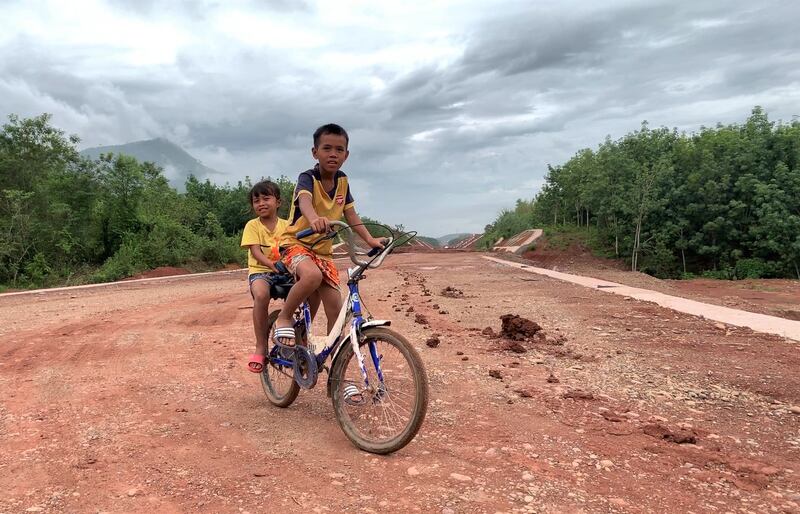Many Lao villagers who were forced to relocate for construction on the Laos-China railway are still waiting for compensation from the government, while others who have received payments say the payments are much lower than they had expected.
The railway project linking landlocked Laos with China has been touted as a benefit to the Lao economy because it will lower the cost of exports and consumer goods while boosting socioeconomic development in the impoverished nation of nearly 7 million people.
The section of railway between Luang Namtha and the capital Vientiane is more than 70 percent complete, which bodes well for the project finishing on schedule in 2021, but villagers who had to give up their houses and land in the name of progress have been waiting for payments from the government, which have been repeatedly delayed.
A villager from Luang Prabang province’s Xiang Ngeun district told RFA’s Lao Service on July 12 that she doesn’t see a future where she and her neighbors will actually receive compensation because it’s been two years since they lost their farmlands.
She said the government went back on its promise of a swift transfer of funds into the villagers’ newly opened bank accounts.
“We haven’t received any compensation from the railway project,” she said.
“I already opened a bank account but no money has been deposited yet. [We the villagers] are waiting but we’ve received nothing,” said the villager.
She said that officials came to meet with the villagers and promised to pay them by the end of June, so they were hopeful that their situation would be resolved, but it is now well into July and they have still received nothing.
She said that the villagers asked district officials again when they could receive payment, and the officials told them to keep waiting and they would receive their money soon.
An official of Xiang Ngeun district said the compensation committee is in the process of preparing compensation for the affected villagers.
“Up until now we have received three payments. We need two more [to have enough funds] to complete the whole compensation,” said the official.
“Our next compensation will be more than 11 billion kip [about $1.26 million] for approximately 30 families. Right now, we’re waiting for approval from the central government,” the official said.
However, the official did not answer how many affected villagers have received compensation and how many remain without payments.

Meanwhile, in Vientiane province’s Hin Heub district, displaced villagers who have received compensation are complaining that it is not enough to cover the expenses of building a new house.
“They gave us only a little bit more than 100 million kip, [less than $12,000], but with just 100 million, we can’t build a new home,” said a Hin Heub resident who heads a family of five.
The man said that he is building his new house by himself, but cannot finish it with just the money the government gave to him. In its current state, whenever it rains he must take his family to hide somewhere else, because the roof leaks.
“The land for our new home was given to us by my grandfather. If we would’ve had to have bought the land then we wouldn’t have any money left to build the house. The compensation we were paid is far less than the 200 [million kip, about $24,000] we expected,” he said.
“We said to the developer that we’d be happy to move for 200, but that’s not what we got,” the man said.
The villager said his case is not unique, and he knows of others who are also not happy with the compensation they received because it was much lower than what they were expecting.
He said they have no choice other than to accept the compensation because the alternative is to receive nothing, while still losing their land and houses.
“We can’t oppose [the government]. We did whatever the project wanted us to do. My new house is not complete; we have to rely on ourselves and work harder to make enough money to complete it,” said the villager.
A Hin Heub district official confirmed that many of the affected families in the district have received compensation and officials are working to complete all compensation claims before mid-2021.
“The project affects 11 villages in total. So far we’ve compensated five,” the official said.
“But that figure is based on initial information. We have new information because in some places the project has changed in scope. According to the new information, we don’t know yet how many more villagers have been compensated because it hasn’t been concluded,” said the official.
According to data collected by RFA’s Lao Service, 138 affected families received compensation in Luang Namtha district, Luang Namtha province, with more 18 in Xai district, Oudomxay province and 38 in Luang Prabang district in Luang Prabang province.
Some of RFA’s figures list villages as having received compensation without listing the number of families. According to the data, 23 villages in Luang Prabang and Vientiane provinces, and 2 in Vientiane capital have received compensation.
RFA’s Lao Service attempted to contact Rattanamany Khounnivong, vice minister at the Lao Ministry of Public Works and Transport, on July 12 and 15 but were unable to reach him.
Reported and translated by RFA’s Lao Service. Written in English by Eugene Whong.

